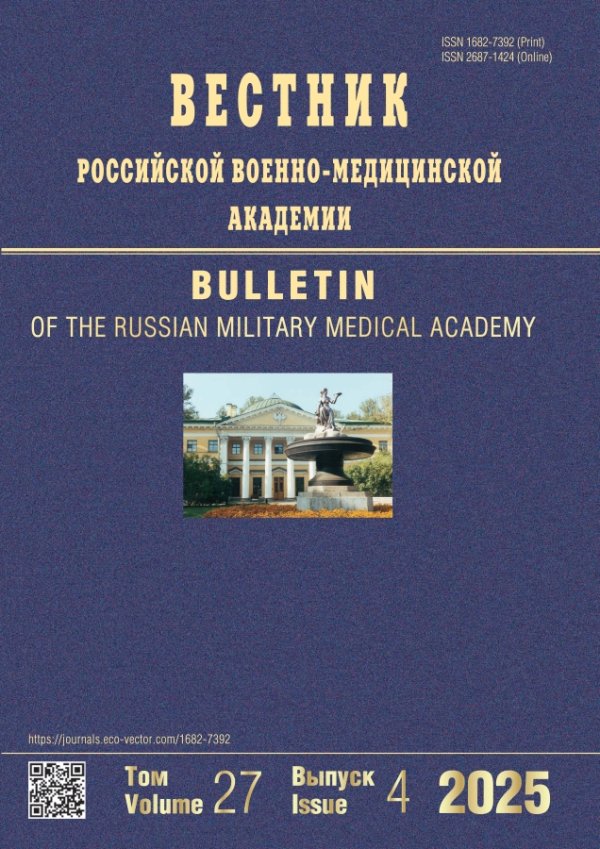Влияние системного воспалительного ответа на адаптивные механизмы и состояние гомеостаза организма у больных туберкулезом органов дыхания в сочетании с хронической обструктивной болезнью легких
- Авторы: Катичева А.В.1, Браженко Н.А.2, Браженко О.Н.2, Чуйкова А.Г.2, Николау А.В.3, Железняк С.Г.4, Цыган Н.В.4
-
Учреждения:
- Первый Санкт-Петербургский государственный медицинский университет им. акад. И.П. Павлова
- Первый Санкт-Петербургский государственный медицинский университет им. акад. И.П. Павлова
- Пушкинский противотуберкулезный диспансер
- Военно-медицинская академия им. С.М. Кирова
- Выпуск: Том 22, № 4 (2020)
- Страницы: 23-27
- Раздел: Клинические исследования
- URL: https://journals.rcsi.science/1682-7392/article/view/62799
- DOI: https://doi.org/10.17816/brmma62799
- ID: 62799
Цитировать
Аннотация
Рассматривается влияние системного воспалительного ответа на адаптивные механизмы и состояние гомеостаза организма у больных туберкулезом органов дыхания на фоне хронической обструктивной болезни легких. Установлено, что туберкулез органов дыхания и хроническая обструктивная болезнь легких имеют широкое распространение среди населения и являются важными причинами бронхолегочной заболеваемости и смертности. Хроническая обструктивная болезнь легких определяется у трети впервые выявленных больных туберкулезом органов дыхания. Сочетанное течение туберкулеза органов дыхания и хронической обструктивной болезни легких представляет собой взаимно отягощающее состояние. Коморбидная патология протекает значительно тяжелее, сопровождается выраженной интоксикацией, распадом легочной ткани и бактериовыделением. Важное клинико-диагностическое значение при хронической обструктивной болезни легких имеют биомаркеры и выраженность системного воспалительного ответа. Определено, что системный воспалительный ответ при хронической обструктивной болезни легких характеризуется эндотелиальной дисфункцией сосудистой стенки, значительными изменениями форменных элементов белой крови, изменениями белкового спектра крови и нарушениями липидного обмена. Проявления системного воспаления и эндотелиальной дисфункции, характерные для хронической обструктивной болезни легких, у больных туберкулезом органов дыхания утяжеляет течение обоих заболеваний. Коморбидное состояние также характеризуется изменением липидного профиля больных, повышением содержания общего холестерина и атерогенных фракций. Эти изменения взаимосвязаны с состоянием адаптивно-приспособительных механизмов, гомеостазом и реактивностью организма. Состояние гомеостаза во многом определяет развитие, течение и исход патологических процессов, характерных для туберкулезного воспаления и воспаления при хронической обструктивной болезни легких, а повышение эффективности проводимого лечения тесно связано с восстановлением гомеостатического равновесия и реактивности организма. Доступность методов определения гомеостатического равновесия организма в клинической практике при их высокой информативности позволяет осуществлять персонифицированный подход к ведению больных с коморбидностью.
Полный текст
Открыть статью на сайте журналаОб авторах
А. В. Катичева
Первый Санкт-Петербургский государственный медицинский университет им. акад. И.П. Павлова
Автор, ответственный за переписку.
Email: an.kati4eva@mail.ru
Россия, Санкт-Петербург
Н. А. Браженко
Первый Санкт-Петербургский государственный медицинский университет им. акад. И.П. Павлова
Email: an.kati4eva@mail.ru
Россия, Санкт-Петербург
О. Н. Браженко
Первый Санкт-Петербургский государственный медицинский университет им. акад. И.П. Павлова
Email: an.kati4eva@mail.ru
Россия, Санкт-Петербург
А. Г. Чуйкова
Первый Санкт-Петербургский государственный медицинский университет им. акад. И.П. Павлова
Email: an.kati4eva@mail.ru
Россия, Санкт-Петербург
А. В. Николау
Пушкинский противотуберкулезный диспансер
Email: an.kati4eva@mail.ru
Россия, Пушкин
С. Г. Железняк
Военно-медицинская академия им. С.М. Кирова
Email: an.kati4eva@mail.ru
Россия, Санкт-Петербург
Н. В. Цыган
Военно-медицинская академия им. С.М. Кирова
Email: an.kati4eva@mail.ru
Россия, Санкт-Петербург
Список литературы
- Авдеев, С.Н. Системные эффекты у больных ХОБЛ / С.Н. Авдеев // Врач. – 2006. – № 12. – С. 3–8.
- Ахминеева, А.Х. Нарушение гомеостаза при хронической обструктивной болезни легких / А.Х. Ахминеева, О.С. Полунина, И.В. Севостьянова // Курский науч.-практ. вестн. «Человек и его здоровье». – 2016. – № 4. – С. 34–39.
- Браженко, Н.А. Туберкулез: гомеостаз организма и эффективность лечения / Н.А. Браженко, О.Н. Браженко. -Васильева, И.А. Заболеваемость, смертность и распространенность как показатели бремени туберкулеза в регионах ВОЗ, странах мира и в Российской Федерации / И.А. Васильева [и др.] // Туберкулез и болезни легких. – 2017. – Т. 95, № 6. – С. 9-Колб, В.Г. Использование теории информации в вопросах реактивности / В.Г. Колб // Биофизические аспекты реактивности организма при туберкулезе. – Минск: Беларусь, 1974. – С. 20–39.
- Мордык, А.В. Распространенность хронической обструктивной болезни легких и отдельных вариантов заболевания среди впервые выявленных больных туберкулезом / А.В. Мордык [и др.] // Мед. альманах. – 2017. – № 4 (49). – С. 120–123.
- Моткина, Е. В. Функциональное состояние эндотелия и хроническое воспаление при хронической обструктивной болезни легких / Е.В. Моткина, В.А. Невзорова // Тихоокеанский мед. журн. – 2005. – № 2 (20). – С. 34–37.
- Никитин, В.А. Комплексный анализ факторов риска, влияющих на прогрессирование хронической обструкивной болезни легких / В.А. Никитин [и др.] // Терапевт. архив. – 2018. – Т. 90, № 1. – С. 27–30.
- Шпрыков, А.С. Клиника и эффективность лечения туберкулеза и бактериальных заболеваний легких в условиях хронической табачной интоксикации (экспериментальные и клинические исследования): дис. … д-ра мед. наук / Шпырков А.С. – М., 2011. – 313 с.
- Эргешов, А.Э. Туберкулез с множественной и широкой лекарственной устойчивостью микобактерий туберкулеза в Российской Федерации // А.Э. Эргешов [и др.] // Вестн. Авиценны. – 2018. – Т. 20, № 2–3. – С. 314–319.
- Jain, N.K. Chronic obstructive pulmonary disease and tuberculosis / N.K. Jain // Lund India. -Kanacia, K.P. High Tobacco Use among Presumptive Tuberculosis Patients, Sought India: Time to integrate Control of two epidemic / K.P. Kanacia [et al.] // Osong. Public. Health Res. Pershect. – 2016. – № 7 (4). – Р. 228–232.
- Liu,Y. Tuberculosis – associated mortality and its risk factors in a district of Shanghail, Chaina: retrospective cohort studynt / Y. Liu // J. Tuberc. Lung. Dis. – 2018. – Vol. 22, № 6. – P. 655–660.
- Rahman, I. Oxidative stress in pathogenesis of chronic obstructive pulmonary disease: cellular and molecular mechanisms / I. Rahman // Cell Biochem Biophys. – 2005. – № 43. – P. 167–88.









